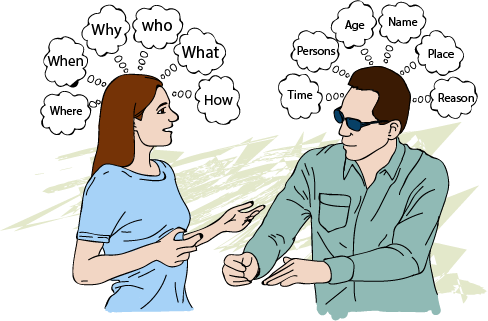Questions: In this section, you are going to learn how to ask questions.
You are going to practice both: open and yes/no questions. For open questions, you are going to use the following words: who, what, where, how, when and why. You can use Wh-words with any tense (past, present or future) but this time, you are going to practice them only with the verb to be because up to now you are only familiar with this verb.
It is possible that you have an idea about how to ask questions using those words. So, it is a good idea to explore your previous knowledge, and in that way, you can learn new information easier.

Analyze these examples:




Imagenes
NA. (2012). Blogs. Taken from: https://pixabay.com/es/blogs-equipo-mujeres-ni%C3%B1a-internet-15968/
Fuhrmann, G. (2014). Chica. Taken from: https://pixabay.com/es/chica-verano-vestido-muy-mujer-571808/
Vasek, J. (2014). Llamada. Taken from: https://pixabay.com/es/iphone-plantilla-maqueta-iphone-6-500291/
http://media.gettyimages.com/photos/knowledge-is-power-picture-id181095659?k=6&m=181095659&s=170667a&w=0&h=SRtkwKYASjrLH5W-YPIJkD_lzccuUMZz2UYax5k4u0A=

By the end of this topic:
• You will be able to use open questions by using Wh-words (who, what, where, how, when and why) to ask and provide personal information in everyday situations. You will also use the negative forms of the present simple in English, using cultural contrasts, to refer to habits.
Before you start working on the activities we have prepared for you, it is essential that you try to recycle previous knowledge.
To do that, you are going to complete the following conversation between two people. You can skip any question you don’t know.
The previous activity was to help you have a general idea about the topic you are working on. Now, you are going to watch a video presentation to learn how to ask and answer personal information questions. You can watch it as many times as necessary.
Asking for ...
Now that you watched the video you can answer the following exercise. You need to identify which question corresponds to each everyday situation.
Scrambled questions!
During the video, you learned how to order or structure different kinds of questions. Now, you have to unscramble the words given to form a question according to the answers provided.
What’s the question?
In the topic presentation, you learned how to ask both: open and yes/no questions. Now, you are going to practice with similar questions, but this time you need to write the full question.
Activity 1
In the presentation section, you learned how to ask different kinds of questions. Keep in mind that information because now you are going to read a text and answer an exercise based on this reading. First, read the following information about Jesus and Helen.


Activity 2
In the presentation section, you explored how to ask questions to get and provide personal information. Now, you are going to play a game based on the audio. It’s essential that you understand both written and spoken English so this activity complements that practice.
Activity 3
When you ask a question about someone else, you need to change the verb to be and the subject. In this exercise, you are going to identify similar questions, but this time you are going to ask questions using “he”, “she” and “they.”
Activity 4
In this activity you are going to practice your speaking, it’s essential to practise this skill because it’s common to be in situations in which you have to talk.
In this activity, you need to imagine the following situation:
You are at a medical congress, and you need to register all the congress assistants. Ask questions to get the following information:
• Full name
• Hometown
• Phone numbers (home and cell phone)
• E-mail
• Facebook account
• Occupation
• Age
 Example
ExampleRecord your eight questions.
Before you record your audio, read these rubrics so that you know the aspects you need to pay special attention when to evaluate yourself then.
If you need to look up any word in a dictionary, we suggest you visit Cambridge Dictionary. You can see the definition and the pronunciation of any word, in case you need it.
At the beginning of this topic, you worked with a text about a student named Romeo and his teacher, Juliet.
• McCarthy M. Dell, F. (2010). Basic Vocabulary in Use. Cambridge: Cambridge University Press.
• Murphy, R. (2006). Basic Grammar in Use, A Self Study Reference and
Practice Book for Elementary Students of English. Cambridge: Cambridge University Press.
• Murphy, R. (2007). Essential Grammar in Use, A Self Study Reference and
Practice Book for Elementary Students of English. Cambridge: Cambridge University Press.
• Sellen, D. (2006). Grammar Tour. A Reference and Practice Grammar for Elementary to Intermediate. Italy: Black Cat.
• Viney, B., et al. (2002). Grammar Practice for Elementary Students. Cambridge: Cambridge University Press.